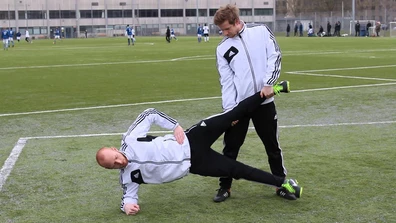How Muscles Tear
March 6, 2019
Muscle tears and muscle strains are common sporting injuries. Particularly now that we are heading into the winter sports season, as they’re relatively common in sports such as Australian rules, rugby, soccer, basketball and netball.
What’s the difference between a muscle ‘tear’ and a muscle ‘strain’?
‘Tear’ and ‘strain’ actually mean the same thing when it comes to muscle injuries. If you have a muscle ‘strain’ you’ve torn some of the fibres of that muscle. It’s a small amount of muscle fibres in the case of a lower grade strain, and a large amount of fibres in the case of a high grade strain. It’s more common for the word ‘strain’ to be used for lower grade injuries, and ‘tear’ to be used for higher grade injuries, but in essence they’re synonymous.
So what makes a muscle tear?
Many people instinctively think a muscle must tear when it is overstretched. But, in fact, a tear is caused by the muscle being forced to be lengthened while it is trying to contract. If it is being lengthened by a greater force than it is able to deal with, then some portion of the tissue will fail and therefore tear.
A common example of how a muscle tears is a hamstring injury sustained during sprinting. Obviously during sprinting you don’t move into a position which places the hamstrings on maximum stretch. While the leg is swinging, the quadriceps pulls the knee straight, while the hamstrings work to control this movement. If the knee is straightening with greater force than the hamstrings are able to counter, some fibres of the hamstrings will fail and tear.

How can we prevent muscle tears?
All this means that tears are the result of a strength deficit rather than a length deficit. Specifically, eccentric strength is important in the prevention of muscle tears. (Eccentric means a muscle being able to absorb force lengthening it, for example the hamstrings controlling the straightening of the knee in the example given above). There’s good evidence that eccentric strengthening is effective in preventing muscle strains, particularly for specific exercises for the hamstrings and the adductors.

Strengthening of muscles which share functions is also likely to help reduce the risk of muscle tears. For examples, hamstrings and the glute max share the role of extending the hip. Strengthening the glute max is therefore likely to reduce the load on the hamstrings and therefore reduce their risk of tear.
A thorough assessment can address other potential contributing factors to the risk of the muscle injuries. Other strategies that are likely to reduce the risk of muscle tears include taping, education and managing increases in training load.
Remember, if you do suffer a muscle injury, treat initially with good acute injury management, and make an appointment to come see our physiotherapist in Aubin Grove to commence your rehab program.
-
 What Can Make Neck Pain a Headache?
What Can Make Neck Pain a Headache?
Often people experiencing a headache are also experiencing neck pain/tightness a...
-
 How Physio Can Help Your Headaches
How Physio Can Help Your Headaches
Headaches are no fun. Some people will only experience short-term headaches ever...
-
 Muscle Strains
Muscle Strains
Winter sports are back and with them come more muscle strains, particularly hams...
